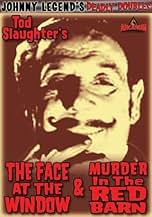Set in France in 1880. A series of murders is attributed to a Wolf Man.Set in France in 1880. A series of murders is attributed to a Wolf Man.Set in France in 1880. A series of murders is attributed to a Wolf Man.
Wallace Evennett
- Professor le Blanc
- (as Wallace Evenett)
Bill Shine
- Pierre
- (as Billy Shine)
Storyline
Did you know
- TriviaOne of over 200 titles in the list of independent feature films made available for television presentation by Advance Television Pictures announced in "Motion Picture Herald", 4 April 1942. At this time, television broadcasting was in its infancy, almost totally curtailed by the advent of World War II, and would not continue to develop until 1945-46. Because of poor documentation (feature films were often not identified by title in conventional sources) no record has yet been found of its initial television broadcast. It's earliest documented USA telecasts took place on American Broadcasting Company's short-lived First Nighter Theatre, aired in New York City Wednesday 15 November 1950 on WJZ (Channel 9), in Los Angeles Tuesday 28 November 1950 on KECA (Channel 13), in San Francisco Monday 4 December 1950 on KGO (Channel 7) and in Philadelphia Friday 30 March 1951 on Friday TV Thriller on WCAU (Channel 10).
- ConnectionsFeatured in Phantom Ferris Theatre: Face at the Window (1959)
Featured review
Forget Karloff & Lugosi. Forget Cushing & Lee, even Price and the Chaneys. Tod is king of horror for one very important reason - he quite evidently enjoys his work. This was the first Tod film I saw and - having heard so much about him prior to this - I feared disappointment. No worries. Despite the cardboard settings and woeful support cast, from the moment he strides masterfully in, we are in the capable hands of a classic film villain. The opening murder with the eerie wolf howl on the soundtracks sets the scene perfectly and then we are treated to an acting masterclass from the great man himself. Whether innocently acting the concerned friend, lecherously trying to sneak a kiss from the heroine, threatening his low-life confederates with a grisly end if they cross him or, worst of all, holding somewhat one-sided conversations with his demented foster brother, Tod holds the film together. The Chevalier is underplayed by Tod compared to Sweeney Todd - but seldom has one man wiggled his eyebrows to more sinister effect. It's a great pity that Universal studios didn't try to to entice him over for their classic horror cycle - Tod would've made a far more spirited Dracula than John Carradine in the later sequels and can't you just see him going toe to toe with Basil Rathbone's Sherlock Holmes. Shame nobody thought of putting him up against Arthur Wontner's in the UK. The double-exposure effects for the appearance of the "face" are well done for their time and the whole film compares favourably with the Universal classics of the period.
The production values are far higher than is normal for a British quota quickie of the period. The contrast between the spacious elegant rooms of the moneyed classes and the clutter of the Blind Rat - with a wealth of extras and charming Parisian detail such as the dancers - more than foreshadows the class-consciousness Hammer brought to its gothics a few decades later. So does the violent action with Lucien using an oil lamp to devastating effect - his disguise as "Renard" could have been a bit more convincing - and Tod making a sudden getaway by leaping from the window of the scientist's house and swimming the Seine to safety. John Warwick and Marjorie Taylor make an appealing couple - although Warwick is no match for Eric Portman in the earlier melodramas - and George King is improving as a director with a tightly edited montage of tense faces as the "corpse" slowly stirs into action to write its incriminating message. Tod is less of a central figure with whom we are expected to side with - even through his setbacks - as Stephen Hawke and Sir Percival Glyde were, but is still a marvellously blackhearted villain, as seen in his unsporting behaviour at the duel with pistols with Lucien. This is his finest film.
The production values are far higher than is normal for a British quota quickie of the period. The contrast between the spacious elegant rooms of the moneyed classes and the clutter of the Blind Rat - with a wealth of extras and charming Parisian detail such as the dancers - more than foreshadows the class-consciousness Hammer brought to its gothics a few decades later. So does the violent action with Lucien using an oil lamp to devastating effect - his disguise as "Renard" could have been a bit more convincing - and Tod making a sudden getaway by leaping from the window of the scientist's house and swimming the Seine to safety. John Warwick and Marjorie Taylor make an appealing couple - although Warwick is no match for Eric Portman in the earlier melodramas - and George King is improving as a director with a tightly edited montage of tense faces as the "corpse" slowly stirs into action to write its incriminating message. Tod is less of a central figure with whom we are expected to side with - even through his setbacks - as Stephen Hawke and Sir Percival Glyde were, but is still a marvellously blackhearted villain, as seen in his unsporting behaviour at the duel with pistols with Lucien. This is his finest film.
- chrismartonuk-1
- Feb 11, 2007
- Permalink
- How long is The Face at the Window?Powered by Alexa
Details
- Runtime1 hour 5 minutes
- Color
- Aspect ratio
- 1.37 : 1
Contribute to this page
Suggest an edit or add missing content

Top Gap
By what name was The Face at the Window (1939) officially released in India in English?
Answer



























